ACCT20075 Auditing and Ethics Report: BOQ Financial Analysis
VerifiedAdded on 2022/09/15
|13
|3014
|37
Report
AI Summary
This report provides a comprehensive analysis of auditing and ethics in relation to the Bank of Queensland (BOQ). It begins by determining the level of materiality, considering profit before tax as the benchmark and applying a 5% materiality percentage, resulting in a materiality level of $24.65 million. The report then performs a preliminary analytical review of BOQ's financial information from 2015 to 2018, utilizing ratio analysis to assess trends in Net Interest Margin, Cost to Income Ratio, Return on Equity, and Capital Adequacy Ratios. The analysis identifies potential areas for audit scrutiny, such as possible manipulation of interest income and overstatement of costs or capital. Furthermore, the report examines the cash flow statement, highlighting the dominance of operating activities in generating cash inflows and the implications for BOQ's going concern risk. Finally, the report reviews the independent auditor's report, noting the unqualified opinion and the emphasis on key audit matters related to loan provisions, goodwill valuation, and IT controls. The report concludes by recommending audit procedures to address the identified risks and ensure the accuracy and fairness of BOQ's financial statements.
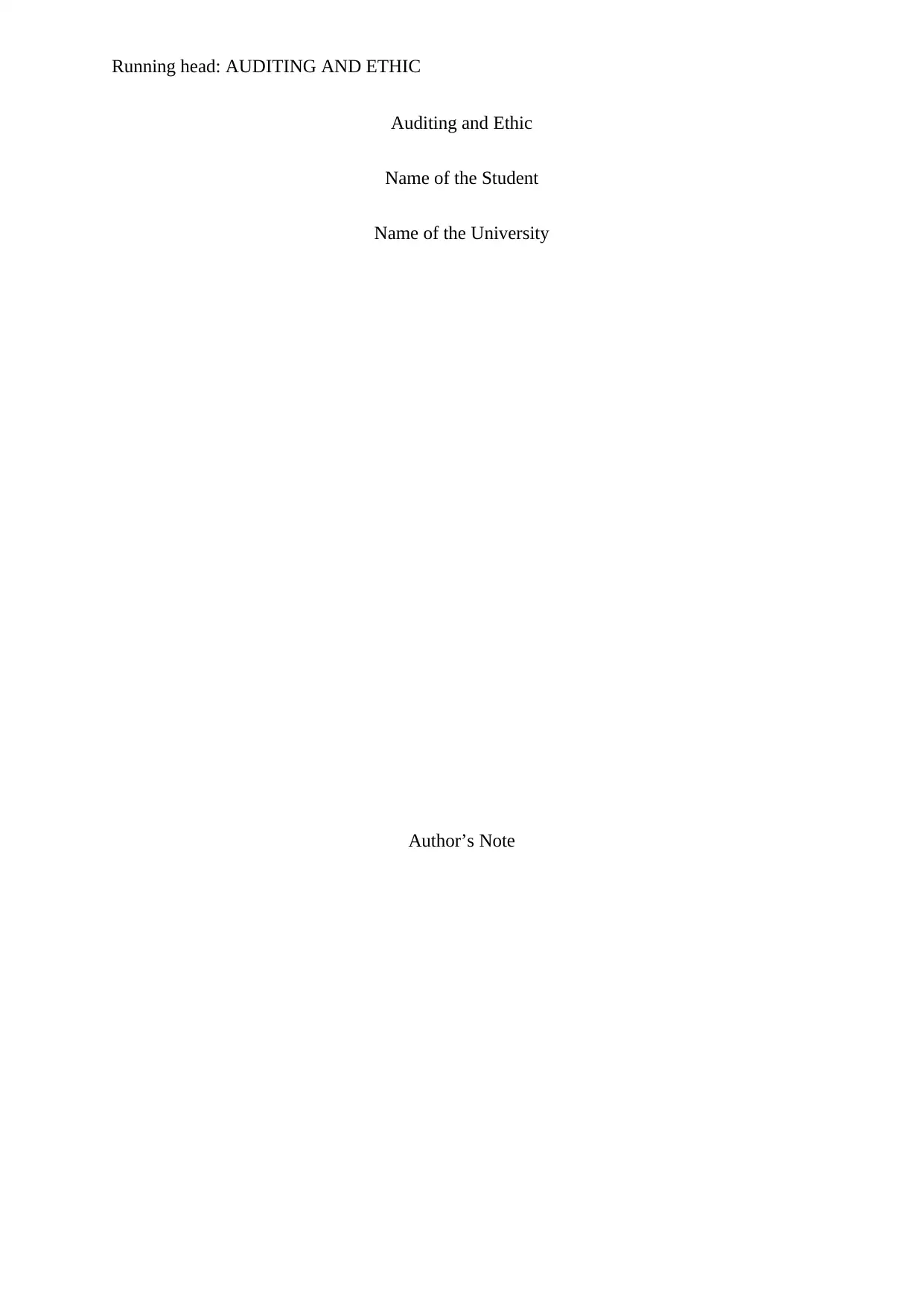
Running head: AUDITING AND ETHIC
Auditing and Ethic
Name of the Student
Name of the University
Author’s Note
Auditing and Ethic
Name of the Student
Name of the University
Author’s Note
Paraphrase This Document
Need a fresh take? Get an instant paraphrase of this document with our AI Paraphraser
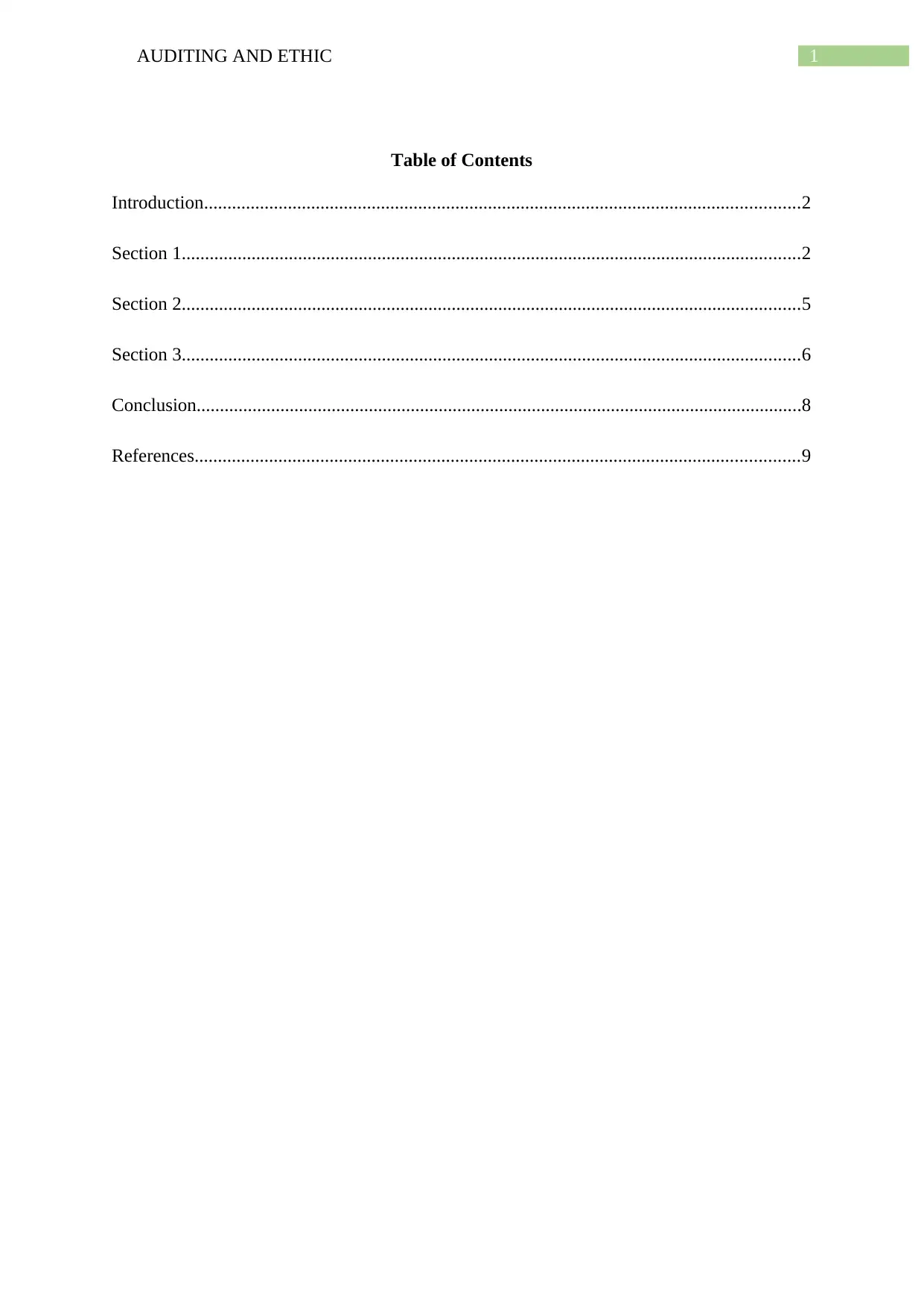
1AUDITING AND ETHIC
Table of Contents
Introduction................................................................................................................................2
Section 1.....................................................................................................................................2
Section 2.....................................................................................................................................5
Section 3.....................................................................................................................................6
Conclusion..................................................................................................................................8
References..................................................................................................................................9
Table of Contents
Introduction................................................................................................................................2
Section 1.....................................................................................................................................2
Section 2.....................................................................................................................................5
Section 3.....................................................................................................................................6
Conclusion..................................................................................................................................8
References..................................................................................................................................9
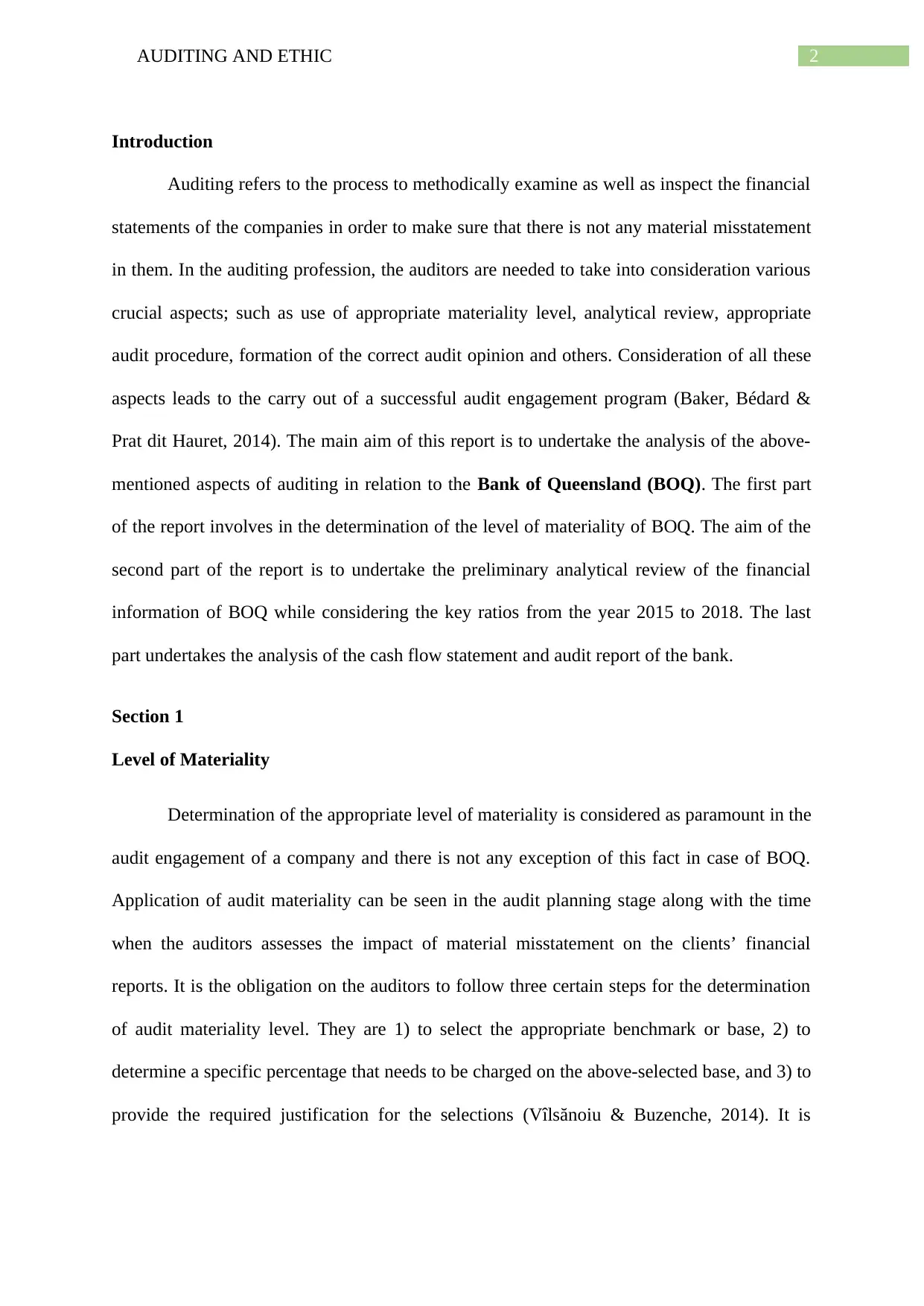
2AUDITING AND ETHIC
Introduction
Auditing refers to the process to methodically examine as well as inspect the financial
statements of the companies in order to make sure that there is not any material misstatement
in them. In the auditing profession, the auditors are needed to take into consideration various
crucial aspects; such as use of appropriate materiality level, analytical review, appropriate
audit procedure, formation of the correct audit opinion and others. Consideration of all these
aspects leads to the carry out of a successful audit engagement program (Baker, Bédard &
Prat dit Hauret, 2014). The main aim of this report is to undertake the analysis of the above-
mentioned aspects of auditing in relation to the Bank of Queensland (BOQ). The first part
of the report involves in the determination of the level of materiality of BOQ. The aim of the
second part of the report is to undertake the preliminary analytical review of the financial
information of BOQ while considering the key ratios from the year 2015 to 2018. The last
part undertakes the analysis of the cash flow statement and audit report of the bank.
Section 1
Level of Materiality
Determination of the appropriate level of materiality is considered as paramount in the
audit engagement of a company and there is not any exception of this fact in case of BOQ.
Application of audit materiality can be seen in the audit planning stage along with the time
when the auditors assesses the impact of material misstatement on the clients’ financial
reports. It is the obligation on the auditors to follow three certain steps for the determination
of audit materiality level. They are 1) to select the appropriate benchmark or base, 2) to
determine a specific percentage that needs to be charged on the above-selected base, and 3) to
provide the required justification for the selections (Vîlsănoiu & Buzenche, 2014). It is
Introduction
Auditing refers to the process to methodically examine as well as inspect the financial
statements of the companies in order to make sure that there is not any material misstatement
in them. In the auditing profession, the auditors are needed to take into consideration various
crucial aspects; such as use of appropriate materiality level, analytical review, appropriate
audit procedure, formation of the correct audit opinion and others. Consideration of all these
aspects leads to the carry out of a successful audit engagement program (Baker, Bédard &
Prat dit Hauret, 2014). The main aim of this report is to undertake the analysis of the above-
mentioned aspects of auditing in relation to the Bank of Queensland (BOQ). The first part
of the report involves in the determination of the level of materiality of BOQ. The aim of the
second part of the report is to undertake the preliminary analytical review of the financial
information of BOQ while considering the key ratios from the year 2015 to 2018. The last
part undertakes the analysis of the cash flow statement and audit report of the bank.
Section 1
Level of Materiality
Determination of the appropriate level of materiality is considered as paramount in the
audit engagement of a company and there is not any exception of this fact in case of BOQ.
Application of audit materiality can be seen in the audit planning stage along with the time
when the auditors assesses the impact of material misstatement on the clients’ financial
reports. It is the obligation on the auditors to follow three certain steps for the determination
of audit materiality level. They are 1) to select the appropriate benchmark or base, 2) to
determine a specific percentage that needs to be charged on the above-selected base, and 3) to
provide the required justification for the selections (Vîlsănoiu & Buzenche, 2014). It is
⊘ This is a preview!⊘
Do you want full access?
Subscribe today to unlock all pages.

Trusted by 1+ million students worldwide
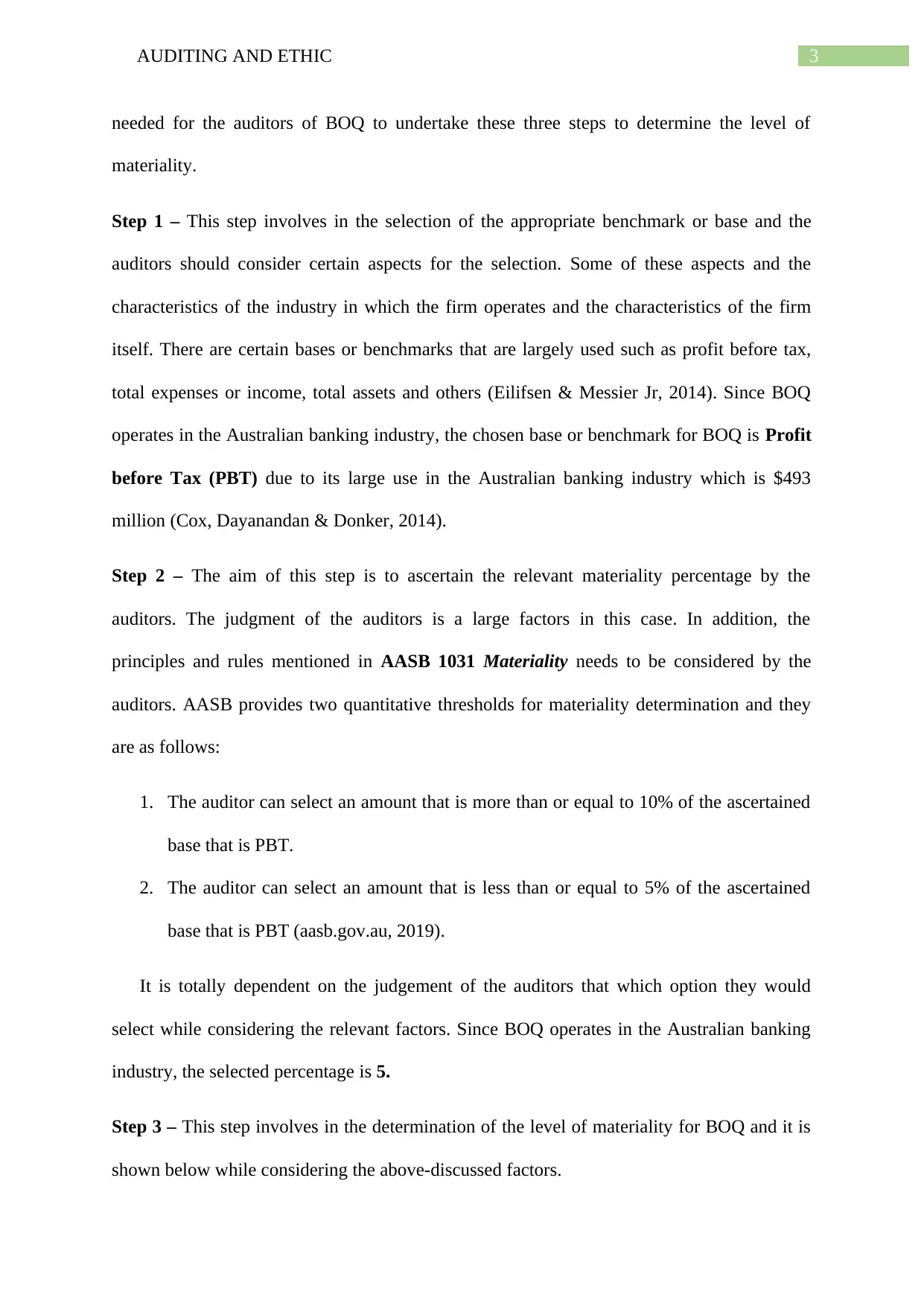
3AUDITING AND ETHIC
needed for the auditors of BOQ to undertake these three steps to determine the level of
materiality.
Step 1 – This step involves in the selection of the appropriate benchmark or base and the
auditors should consider certain aspects for the selection. Some of these aspects and the
characteristics of the industry in which the firm operates and the characteristics of the firm
itself. There are certain bases or benchmarks that are largely used such as profit before tax,
total expenses or income, total assets and others (Eilifsen & Messier Jr, 2014). Since BOQ
operates in the Australian banking industry, the chosen base or benchmark for BOQ is Profit
before Tax (PBT) due to its large use in the Australian banking industry which is $493
million (Cox, Dayanandan & Donker, 2014).
Step 2 – The aim of this step is to ascertain the relevant materiality percentage by the
auditors. The judgment of the auditors is a large factors in this case. In addition, the
principles and rules mentioned in AASB 1031 Materiality needs to be considered by the
auditors. AASB provides two quantitative thresholds for materiality determination and they
are as follows:
1. The auditor can select an amount that is more than or equal to 10% of the ascertained
base that is PBT.
2. The auditor can select an amount that is less than or equal to 5% of the ascertained
base that is PBT (aasb.gov.au, 2019).
It is totally dependent on the judgement of the auditors that which option they would
select while considering the relevant factors. Since BOQ operates in the Australian banking
industry, the selected percentage is 5.
Step 3 – This step involves in the determination of the level of materiality for BOQ and it is
shown below while considering the above-discussed factors.
needed for the auditors of BOQ to undertake these three steps to determine the level of
materiality.
Step 1 – This step involves in the selection of the appropriate benchmark or base and the
auditors should consider certain aspects for the selection. Some of these aspects and the
characteristics of the industry in which the firm operates and the characteristics of the firm
itself. There are certain bases or benchmarks that are largely used such as profit before tax,
total expenses or income, total assets and others (Eilifsen & Messier Jr, 2014). Since BOQ
operates in the Australian banking industry, the chosen base or benchmark for BOQ is Profit
before Tax (PBT) due to its large use in the Australian banking industry which is $493
million (Cox, Dayanandan & Donker, 2014).
Step 2 – The aim of this step is to ascertain the relevant materiality percentage by the
auditors. The judgment of the auditors is a large factors in this case. In addition, the
principles and rules mentioned in AASB 1031 Materiality needs to be considered by the
auditors. AASB provides two quantitative thresholds for materiality determination and they
are as follows:
1. The auditor can select an amount that is more than or equal to 10% of the ascertained
base that is PBT.
2. The auditor can select an amount that is less than or equal to 5% of the ascertained
base that is PBT (aasb.gov.au, 2019).
It is totally dependent on the judgement of the auditors that which option they would
select while considering the relevant factors. Since BOQ operates in the Australian banking
industry, the selected percentage is 5.
Step 3 – This step involves in the determination of the level of materiality for BOQ and it is
shown below while considering the above-discussed factors.
Paraphrase This Document
Need a fresh take? Get an instant paraphrase of this document with our AI Paraphraser
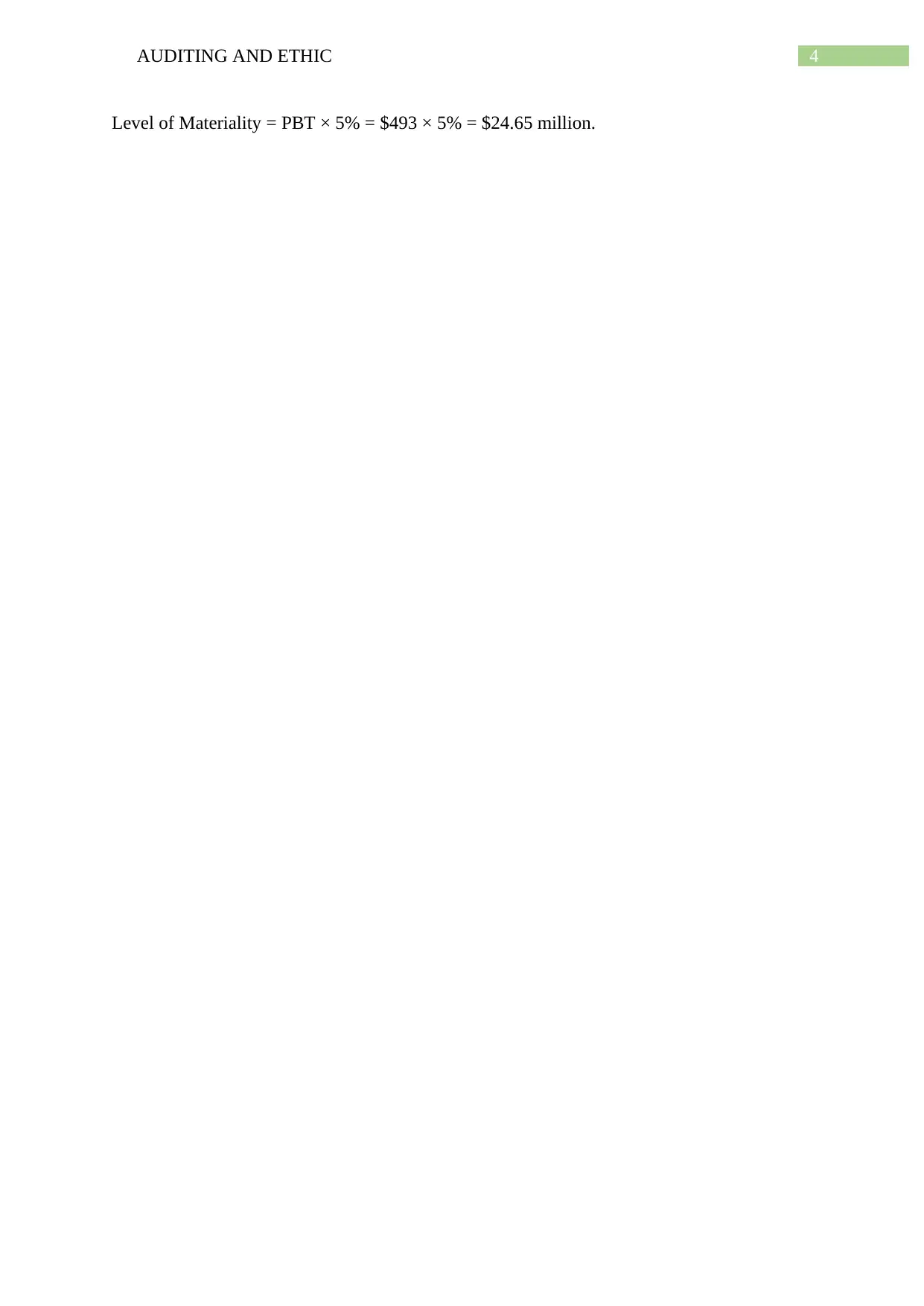
4AUDITING AND ETHIC
Level of Materiality = PBT × 5% = $493 × 5% = $24.65 million.
Level of Materiality = PBT × 5% = $493 × 5% = $24.65 million.
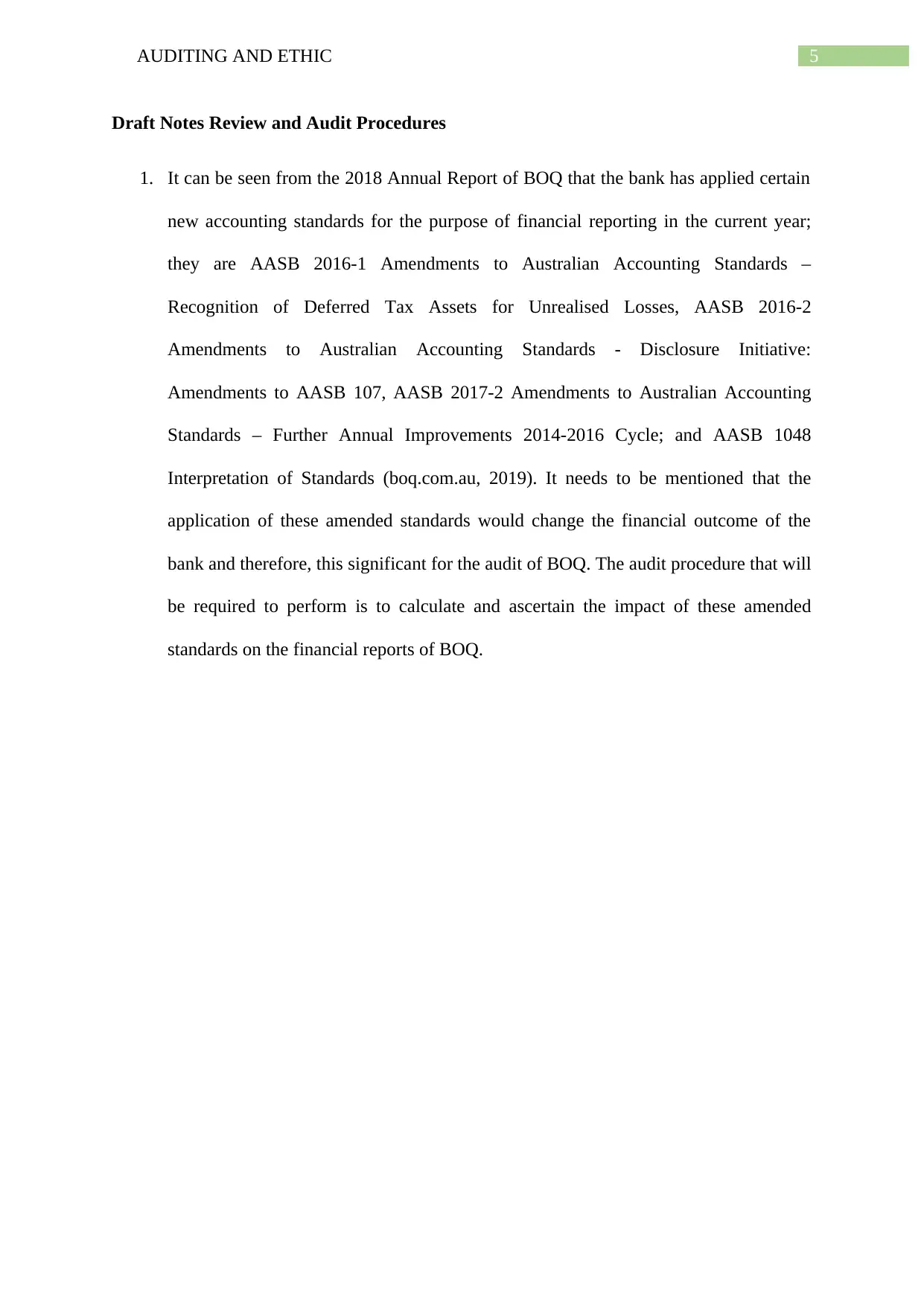
5AUDITING AND ETHIC
Draft Notes Review and Audit Procedures
1. It can be seen from the 2018 Annual Report of BOQ that the bank has applied certain
new accounting standards for the purpose of financial reporting in the current year;
they are AASB 2016-1 Amendments to Australian Accounting Standards –
Recognition of Deferred Tax Assets for Unrealised Losses, AASB 2016-2
Amendments to Australian Accounting Standards - Disclosure Initiative:
Amendments to AASB 107, AASB 2017-2 Amendments to Australian Accounting
Standards – Further Annual Improvements 2014-2016 Cycle; and AASB 1048
Interpretation of Standards (boq.com.au, 2019). It needs to be mentioned that the
application of these amended standards would change the financial outcome of the
bank and therefore, this significant for the audit of BOQ. The audit procedure that will
be required to perform is to calculate and ascertain the impact of these amended
standards on the financial reports of BOQ.
Draft Notes Review and Audit Procedures
1. It can be seen from the 2018 Annual Report of BOQ that the bank has applied certain
new accounting standards for the purpose of financial reporting in the current year;
they are AASB 2016-1 Amendments to Australian Accounting Standards –
Recognition of Deferred Tax Assets for Unrealised Losses, AASB 2016-2
Amendments to Australian Accounting Standards - Disclosure Initiative:
Amendments to AASB 107, AASB 2017-2 Amendments to Australian Accounting
Standards – Further Annual Improvements 2014-2016 Cycle; and AASB 1048
Interpretation of Standards (boq.com.au, 2019). It needs to be mentioned that the
application of these amended standards would change the financial outcome of the
bank and therefore, this significant for the audit of BOQ. The audit procedure that will
be required to perform is to calculate and ascertain the impact of these amended
standards on the financial reports of BOQ.
⊘ This is a preview!⊘
Do you want full access?
Subscribe today to unlock all pages.

Trusted by 1+ million students worldwide
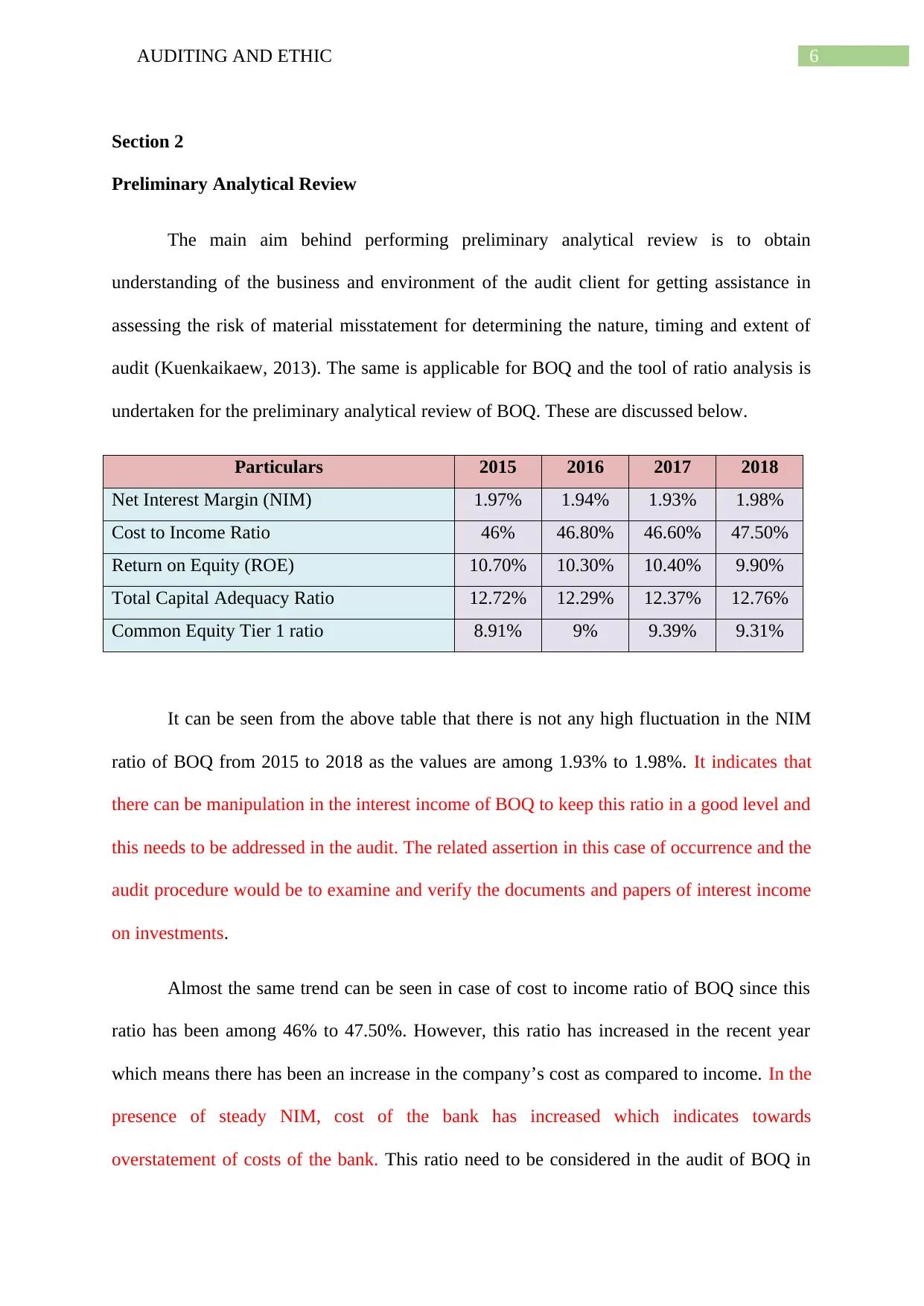
6AUDITING AND ETHIC
Section 2
Preliminary Analytical Review
The main aim behind performing preliminary analytical review is to obtain
understanding of the business and environment of the audit client for getting assistance in
assessing the risk of material misstatement for determining the nature, timing and extent of
audit (Kuenkaikaew, 2013). The same is applicable for BOQ and the tool of ratio analysis is
undertaken for the preliminary analytical review of BOQ. These are discussed below.
Particulars 2015 2016 2017 2018
Net Interest Margin (NIM) 1.97% 1.94% 1.93% 1.98%
Cost to Income Ratio 46% 46.80% 46.60% 47.50%
Return on Equity (ROE) 10.70% 10.30% 10.40% 9.90%
Total Capital Adequacy Ratio 12.72% 12.29% 12.37% 12.76%
Common Equity Tier 1 ratio 8.91% 9% 9.39% 9.31%
It can be seen from the above table that there is not any high fluctuation in the NIM
ratio of BOQ from 2015 to 2018 as the values are among 1.93% to 1.98%. It indicates that
there can be manipulation in the interest income of BOQ to keep this ratio in a good level and
this needs to be addressed in the audit. The related assertion in this case of occurrence and the
audit procedure would be to examine and verify the documents and papers of interest income
on investments.
Almost the same trend can be seen in case of cost to income ratio of BOQ since this
ratio has been among 46% to 47.50%. However, this ratio has increased in the recent year
which means there has been an increase in the company’s cost as compared to income. In the
presence of steady NIM, cost of the bank has increased which indicates towards
overstatement of costs of the bank. This ratio need to be considered in the audit of BOQ in
Section 2
Preliminary Analytical Review
The main aim behind performing preliminary analytical review is to obtain
understanding of the business and environment of the audit client for getting assistance in
assessing the risk of material misstatement for determining the nature, timing and extent of
audit (Kuenkaikaew, 2013). The same is applicable for BOQ and the tool of ratio analysis is
undertaken for the preliminary analytical review of BOQ. These are discussed below.
Particulars 2015 2016 2017 2018
Net Interest Margin (NIM) 1.97% 1.94% 1.93% 1.98%
Cost to Income Ratio 46% 46.80% 46.60% 47.50%
Return on Equity (ROE) 10.70% 10.30% 10.40% 9.90%
Total Capital Adequacy Ratio 12.72% 12.29% 12.37% 12.76%
Common Equity Tier 1 ratio 8.91% 9% 9.39% 9.31%
It can be seen from the above table that there is not any high fluctuation in the NIM
ratio of BOQ from 2015 to 2018 as the values are among 1.93% to 1.98%. It indicates that
there can be manipulation in the interest income of BOQ to keep this ratio in a good level and
this needs to be addressed in the audit. The related assertion in this case of occurrence and the
audit procedure would be to examine and verify the documents and papers of interest income
on investments.
Almost the same trend can be seen in case of cost to income ratio of BOQ since this
ratio has been among 46% to 47.50%. However, this ratio has increased in the recent year
which means there has been an increase in the company’s cost as compared to income. In the
presence of steady NIM, cost of the bank has increased which indicates towards
overstatement of costs of the bank. This ratio need to be considered in the audit of BOQ in
Paraphrase This Document
Need a fresh take? Get an instant paraphrase of this document with our AI Paraphraser
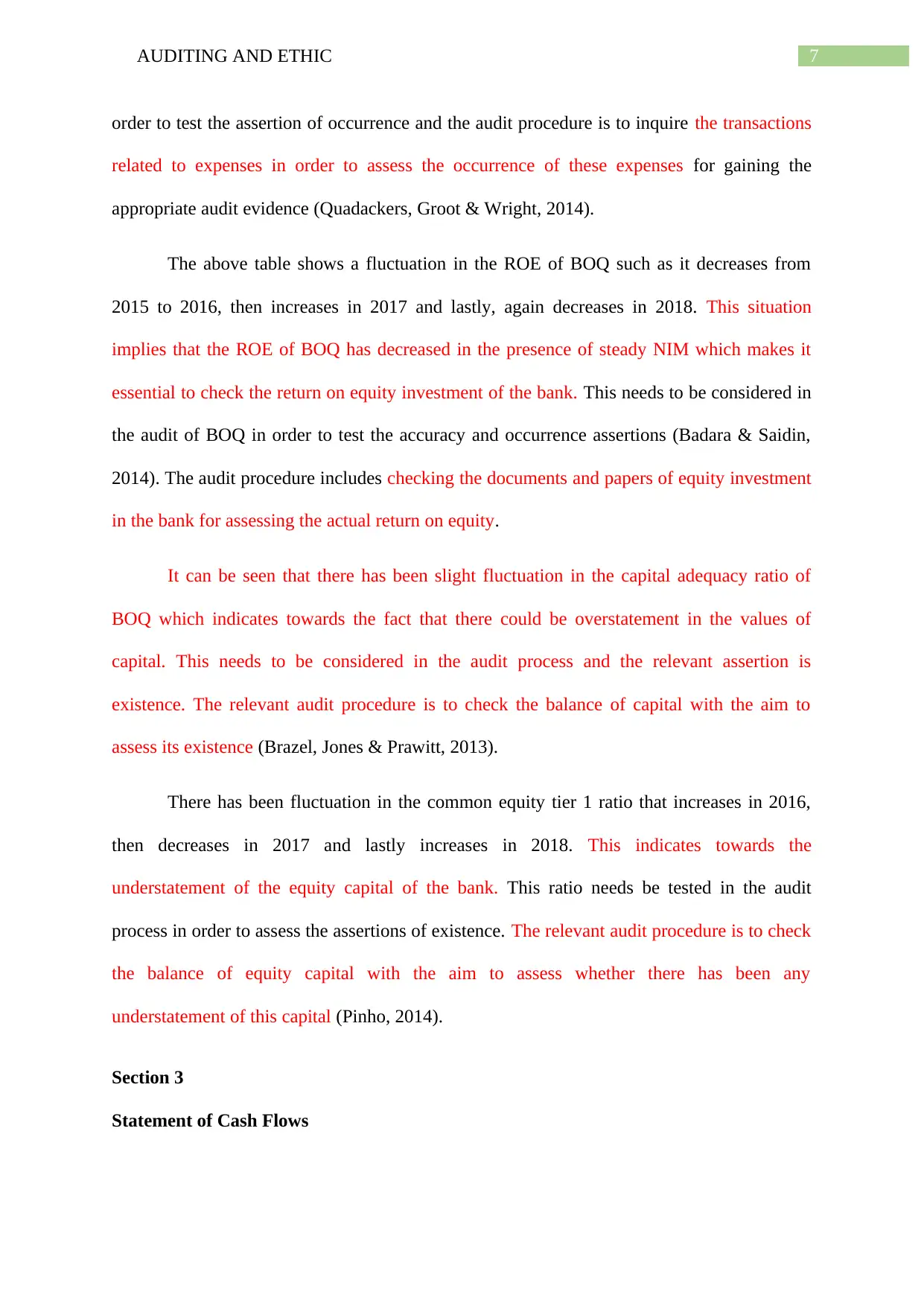
7AUDITING AND ETHIC
order to test the assertion of occurrence and the audit procedure is to inquire the transactions
related to expenses in order to assess the occurrence of these expenses for gaining the
appropriate audit evidence (Quadackers, Groot & Wright, 2014).
The above table shows a fluctuation in the ROE of BOQ such as it decreases from
2015 to 2016, then increases in 2017 and lastly, again decreases in 2018. This situation
implies that the ROE of BOQ has decreased in the presence of steady NIM which makes it
essential to check the return on equity investment of the bank. This needs to be considered in
the audit of BOQ in order to test the accuracy and occurrence assertions (Badara & Saidin,
2014). The audit procedure includes checking the documents and papers of equity investment
in the bank for assessing the actual return on equity.
It can be seen that there has been slight fluctuation in the capital adequacy ratio of
BOQ which indicates towards the fact that there could be overstatement in the values of
capital. This needs to be considered in the audit process and the relevant assertion is
existence. The relevant audit procedure is to check the balance of capital with the aim to
assess its existence (Brazel, Jones & Prawitt, 2013).
There has been fluctuation in the common equity tier 1 ratio that increases in 2016,
then decreases in 2017 and lastly increases in 2018. This indicates towards the
understatement of the equity capital of the bank. This ratio needs be tested in the audit
process in order to assess the assertions of existence. The relevant audit procedure is to check
the balance of equity capital with the aim to assess whether there has been any
understatement of this capital (Pinho, 2014).
Section 3
Statement of Cash Flows
order to test the assertion of occurrence and the audit procedure is to inquire the transactions
related to expenses in order to assess the occurrence of these expenses for gaining the
appropriate audit evidence (Quadackers, Groot & Wright, 2014).
The above table shows a fluctuation in the ROE of BOQ such as it decreases from
2015 to 2016, then increases in 2017 and lastly, again decreases in 2018. This situation
implies that the ROE of BOQ has decreased in the presence of steady NIM which makes it
essential to check the return on equity investment of the bank. This needs to be considered in
the audit of BOQ in order to test the accuracy and occurrence assertions (Badara & Saidin,
2014). The audit procedure includes checking the documents and papers of equity investment
in the bank for assessing the actual return on equity.
It can be seen that there has been slight fluctuation in the capital adequacy ratio of
BOQ which indicates towards the fact that there could be overstatement in the values of
capital. This needs to be considered in the audit process and the relevant assertion is
existence. The relevant audit procedure is to check the balance of capital with the aim to
assess its existence (Brazel, Jones & Prawitt, 2013).
There has been fluctuation in the common equity tier 1 ratio that increases in 2016,
then decreases in 2017 and lastly increases in 2018. This indicates towards the
understatement of the equity capital of the bank. This ratio needs be tested in the audit
process in order to assess the assertions of existence. The relevant audit procedure is to check
the balance of equity capital with the aim to assess whether there has been any
understatement of this capital (Pinho, 2014).
Section 3
Statement of Cash Flows
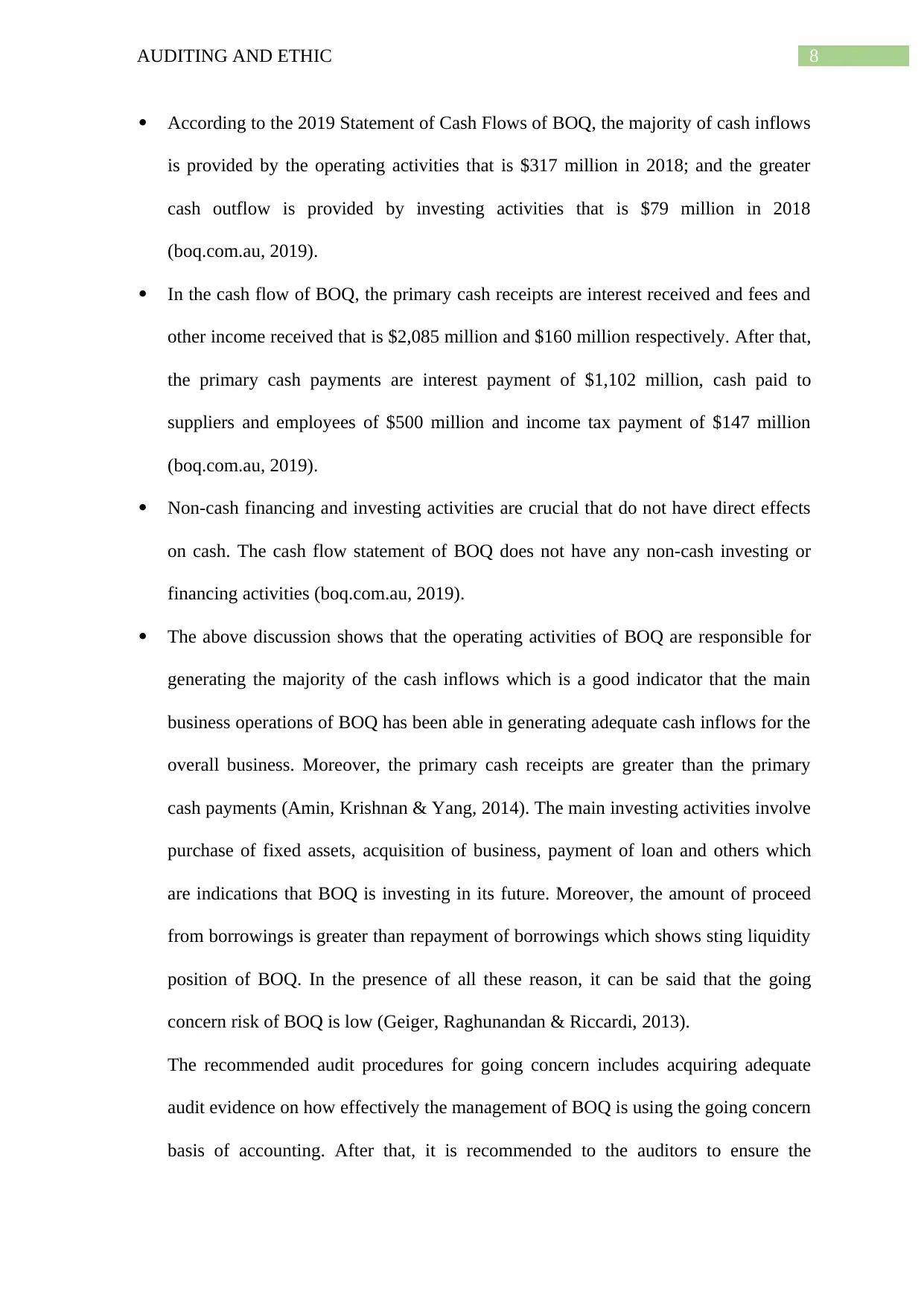
8AUDITING AND ETHIC
According to the 2019 Statement of Cash Flows of BOQ, the majority of cash inflows
is provided by the operating activities that is $317 million in 2018; and the greater
cash outflow is provided by investing activities that is $79 million in 2018
(boq.com.au, 2019).
In the cash flow of BOQ, the primary cash receipts are interest received and fees and
other income received that is $2,085 million and $160 million respectively. After that,
the primary cash payments are interest payment of $1,102 million, cash paid to
suppliers and employees of $500 million and income tax payment of $147 million
(boq.com.au, 2019).
Non-cash financing and investing activities are crucial that do not have direct effects
on cash. The cash flow statement of BOQ does not have any non-cash investing or
financing activities (boq.com.au, 2019).
The above discussion shows that the operating activities of BOQ are responsible for
generating the majority of the cash inflows which is a good indicator that the main
business operations of BOQ has been able in generating adequate cash inflows for the
overall business. Moreover, the primary cash receipts are greater than the primary
cash payments (Amin, Krishnan & Yang, 2014). The main investing activities involve
purchase of fixed assets, acquisition of business, payment of loan and others which
are indications that BOQ is investing in its future. Moreover, the amount of proceed
from borrowings is greater than repayment of borrowings which shows sting liquidity
position of BOQ. In the presence of all these reason, it can be said that the going
concern risk of BOQ is low (Geiger, Raghunandan & Riccardi, 2013).
The recommended audit procedures for going concern includes acquiring adequate
audit evidence on how effectively the management of BOQ is using the going concern
basis of accounting. After that, it is recommended to the auditors to ensure the
According to the 2019 Statement of Cash Flows of BOQ, the majority of cash inflows
is provided by the operating activities that is $317 million in 2018; and the greater
cash outflow is provided by investing activities that is $79 million in 2018
(boq.com.au, 2019).
In the cash flow of BOQ, the primary cash receipts are interest received and fees and
other income received that is $2,085 million and $160 million respectively. After that,
the primary cash payments are interest payment of $1,102 million, cash paid to
suppliers and employees of $500 million and income tax payment of $147 million
(boq.com.au, 2019).
Non-cash financing and investing activities are crucial that do not have direct effects
on cash. The cash flow statement of BOQ does not have any non-cash investing or
financing activities (boq.com.au, 2019).
The above discussion shows that the operating activities of BOQ are responsible for
generating the majority of the cash inflows which is a good indicator that the main
business operations of BOQ has been able in generating adequate cash inflows for the
overall business. Moreover, the primary cash receipts are greater than the primary
cash payments (Amin, Krishnan & Yang, 2014). The main investing activities involve
purchase of fixed assets, acquisition of business, payment of loan and others which
are indications that BOQ is investing in its future. Moreover, the amount of proceed
from borrowings is greater than repayment of borrowings which shows sting liquidity
position of BOQ. In the presence of all these reason, it can be said that the going
concern risk of BOQ is low (Geiger, Raghunandan & Riccardi, 2013).
The recommended audit procedures for going concern includes acquiring adequate
audit evidence on how effectively the management of BOQ is using the going concern
basis of accounting. After that, it is recommended to the auditors to ensure the
⊘ This is a preview!⊘
Do you want full access?
Subscribe today to unlock all pages.

Trusted by 1+ million students worldwide
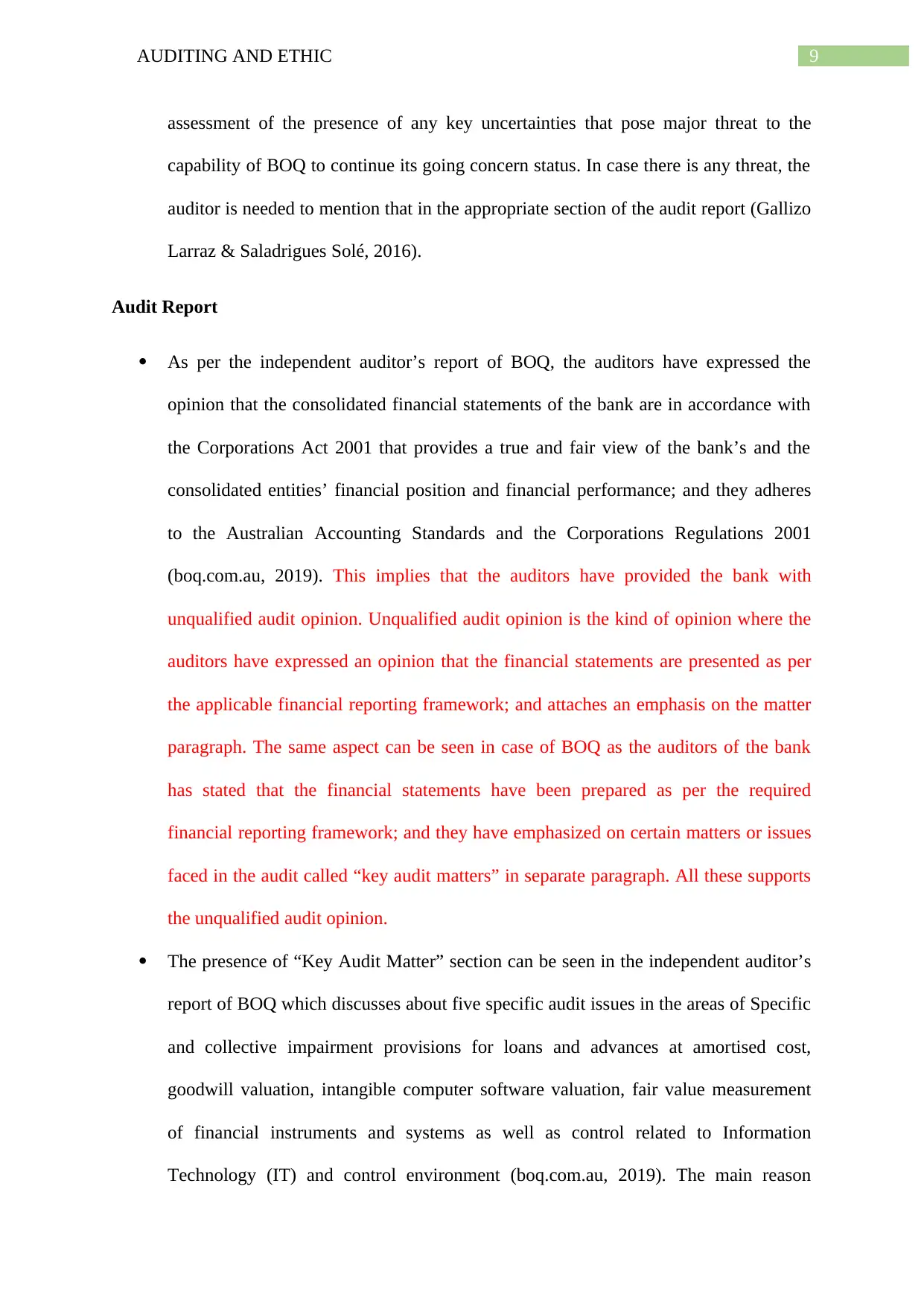
9AUDITING AND ETHIC
assessment of the presence of any key uncertainties that pose major threat to the
capability of BOQ to continue its going concern status. In case there is any threat, the
auditor is needed to mention that in the appropriate section of the audit report (Gallizo
Larraz & Saladrigues Solé, 2016).
Audit Report
As per the independent auditor’s report of BOQ, the auditors have expressed the
opinion that the consolidated financial statements of the bank are in accordance with
the Corporations Act 2001 that provides a true and fair view of the bank’s and the
consolidated entities’ financial position and financial performance; and they adheres
to the Australian Accounting Standards and the Corporations Regulations 2001
(boq.com.au, 2019). This implies that the auditors have provided the bank with
unqualified audit opinion. Unqualified audit opinion is the kind of opinion where the
auditors have expressed an opinion that the financial statements are presented as per
the applicable financial reporting framework; and attaches an emphasis on the matter
paragraph. The same aspect can be seen in case of BOQ as the auditors of the bank
has stated that the financial statements have been prepared as per the required
financial reporting framework; and they have emphasized on certain matters or issues
faced in the audit called “key audit matters” in separate paragraph. All these supports
the unqualified audit opinion.
The presence of “Key Audit Matter” section can be seen in the independent auditor’s
report of BOQ which discusses about five specific audit issues in the areas of Specific
and collective impairment provisions for loans and advances at amortised cost,
goodwill valuation, intangible computer software valuation, fair value measurement
of financial instruments and systems as well as control related to Information
Technology (IT) and control environment (boq.com.au, 2019). The main reason
assessment of the presence of any key uncertainties that pose major threat to the
capability of BOQ to continue its going concern status. In case there is any threat, the
auditor is needed to mention that in the appropriate section of the audit report (Gallizo
Larraz & Saladrigues Solé, 2016).
Audit Report
As per the independent auditor’s report of BOQ, the auditors have expressed the
opinion that the consolidated financial statements of the bank are in accordance with
the Corporations Act 2001 that provides a true and fair view of the bank’s and the
consolidated entities’ financial position and financial performance; and they adheres
to the Australian Accounting Standards and the Corporations Regulations 2001
(boq.com.au, 2019). This implies that the auditors have provided the bank with
unqualified audit opinion. Unqualified audit opinion is the kind of opinion where the
auditors have expressed an opinion that the financial statements are presented as per
the applicable financial reporting framework; and attaches an emphasis on the matter
paragraph. The same aspect can be seen in case of BOQ as the auditors of the bank
has stated that the financial statements have been prepared as per the required
financial reporting framework; and they have emphasized on certain matters or issues
faced in the audit called “key audit matters” in separate paragraph. All these supports
the unqualified audit opinion.
The presence of “Key Audit Matter” section can be seen in the independent auditor’s
report of BOQ which discusses about five specific audit issues in the areas of Specific
and collective impairment provisions for loans and advances at amortised cost,
goodwill valuation, intangible computer software valuation, fair value measurement
of financial instruments and systems as well as control related to Information
Technology (IT) and control environment (boq.com.au, 2019). The main reason
Paraphrase This Document
Need a fresh take? Get an instant paraphrase of this document with our AI Paraphraser
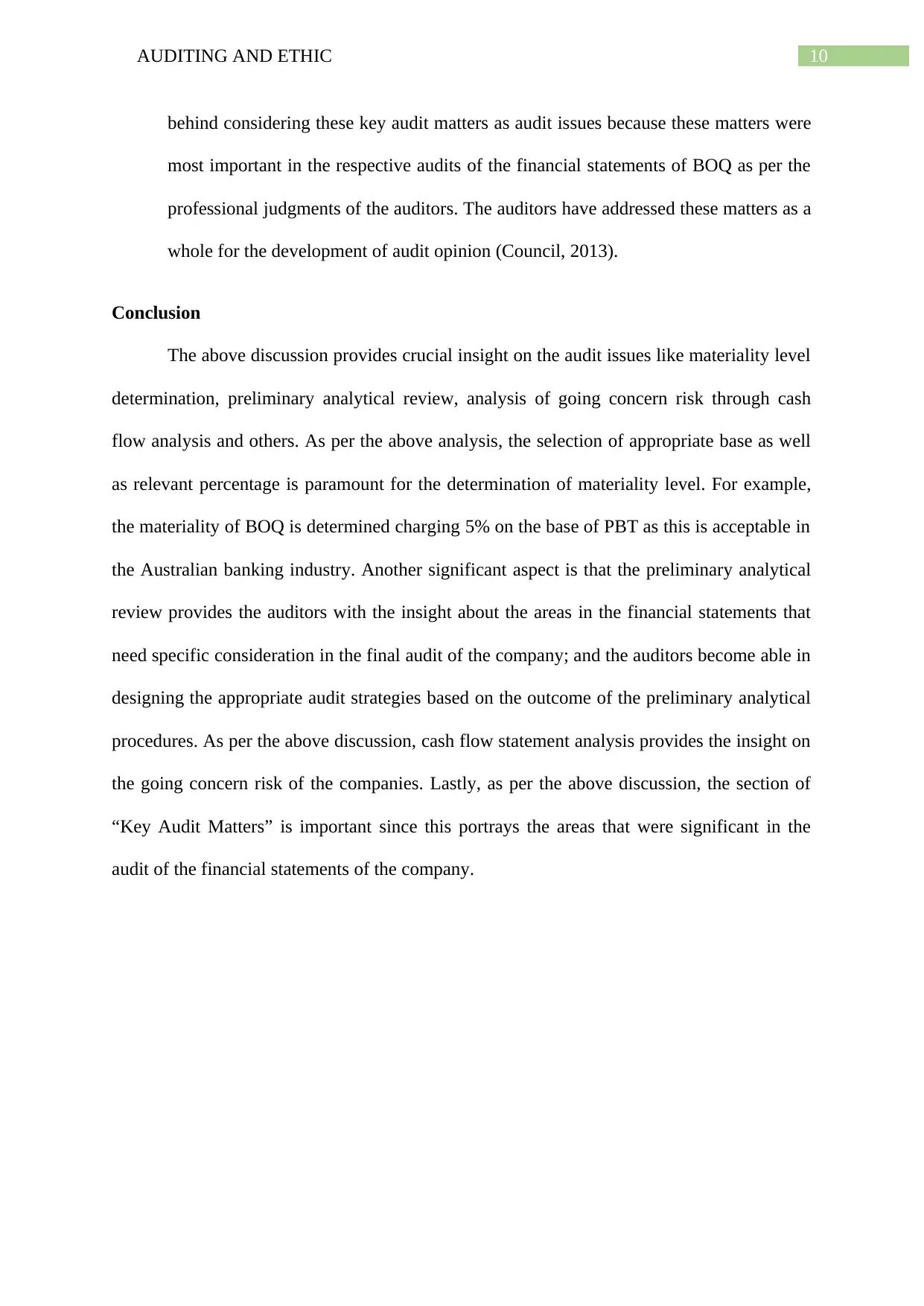
10AUDITING AND ETHIC
behind considering these key audit matters as audit issues because these matters were
most important in the respective audits of the financial statements of BOQ as per the
professional judgments of the auditors. The auditors have addressed these matters as a
whole for the development of audit opinion (Council, 2013).
Conclusion
The above discussion provides crucial insight on the audit issues like materiality level
determination, preliminary analytical review, analysis of going concern risk through cash
flow analysis and others. As per the above analysis, the selection of appropriate base as well
as relevant percentage is paramount for the determination of materiality level. For example,
the materiality of BOQ is determined charging 5% on the base of PBT as this is acceptable in
the Australian banking industry. Another significant aspect is that the preliminary analytical
review provides the auditors with the insight about the areas in the financial statements that
need specific consideration in the final audit of the company; and the auditors become able in
designing the appropriate audit strategies based on the outcome of the preliminary analytical
procedures. As per the above discussion, cash flow statement analysis provides the insight on
the going concern risk of the companies. Lastly, as per the above discussion, the section of
“Key Audit Matters” is important since this portrays the areas that were significant in the
audit of the financial statements of the company.
behind considering these key audit matters as audit issues because these matters were
most important in the respective audits of the financial statements of BOQ as per the
professional judgments of the auditors. The auditors have addressed these matters as a
whole for the development of audit opinion (Council, 2013).
Conclusion
The above discussion provides crucial insight on the audit issues like materiality level
determination, preliminary analytical review, analysis of going concern risk through cash
flow analysis and others. As per the above analysis, the selection of appropriate base as well
as relevant percentage is paramount for the determination of materiality level. For example,
the materiality of BOQ is determined charging 5% on the base of PBT as this is acceptable in
the Australian banking industry. Another significant aspect is that the preliminary analytical
review provides the auditors with the insight about the areas in the financial statements that
need specific consideration in the final audit of the company; and the auditors become able in
designing the appropriate audit strategies based on the outcome of the preliminary analytical
procedures. As per the above discussion, cash flow statement analysis provides the insight on
the going concern risk of the companies. Lastly, as per the above discussion, the section of
“Key Audit Matters” is important since this portrays the areas that were significant in the
audit of the financial statements of the company.
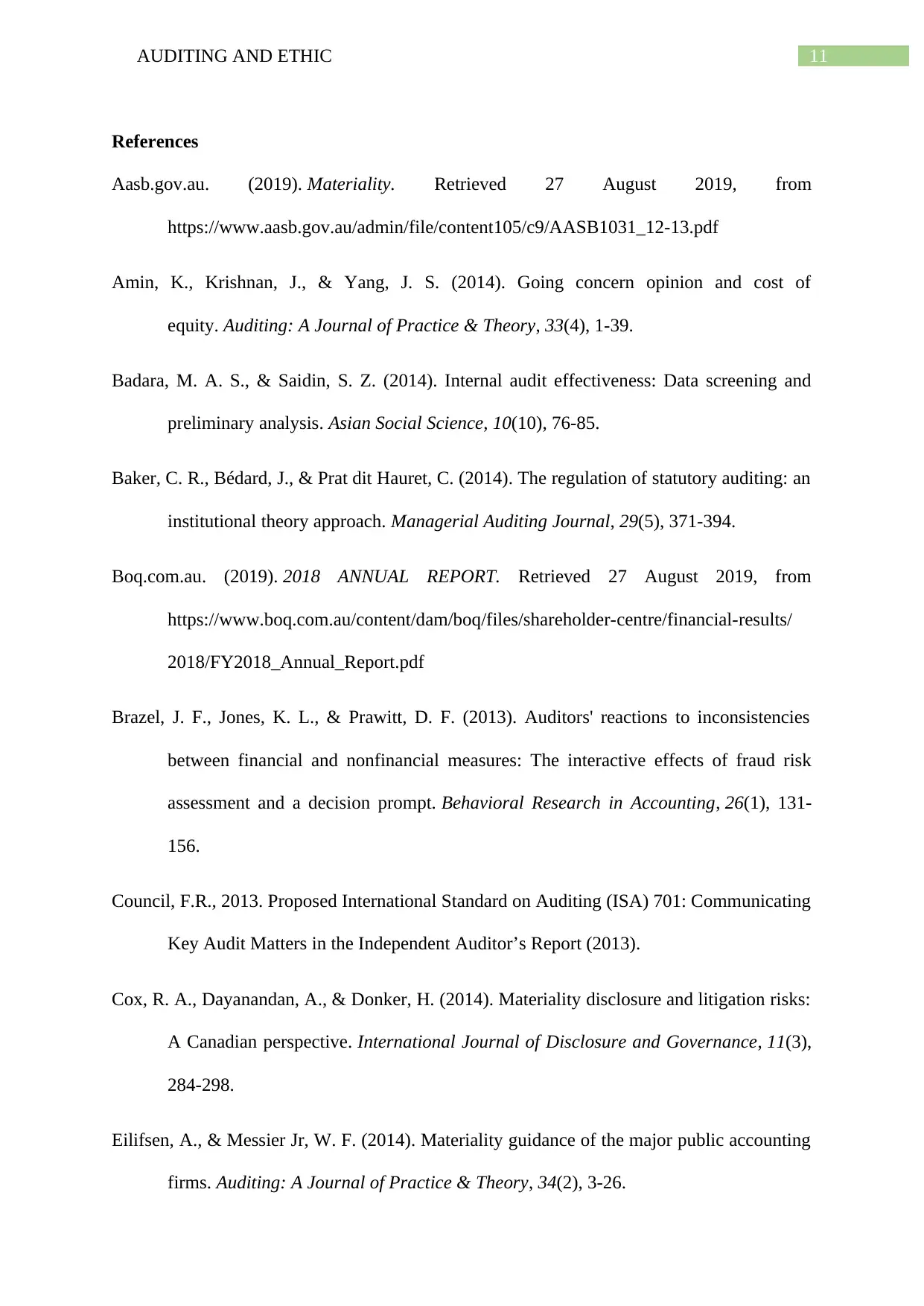
11AUDITING AND ETHIC
References
Aasb.gov.au. (2019). Materiality. Retrieved 27 August 2019, from
https://www.aasb.gov.au/admin/file/content105/c9/AASB1031_12-13.pdf
Amin, K., Krishnan, J., & Yang, J. S. (2014). Going concern opinion and cost of
equity. Auditing: A Journal of Practice & Theory, 33(4), 1-39.
Badara, M. A. S., & Saidin, S. Z. (2014). Internal audit effectiveness: Data screening and
preliminary analysis. Asian Social Science, 10(10), 76-85.
Baker, C. R., Bédard, J., & Prat dit Hauret, C. (2014). The regulation of statutory auditing: an
institutional theory approach. Managerial Auditing Journal, 29(5), 371-394.
Boq.com.au. (2019). 2018 ANNUAL REPORT. Retrieved 27 August 2019, from
https://www.boq.com.au/content/dam/boq/files/shareholder-centre/financial-results/
2018/FY2018_Annual_Report.pdf
Brazel, J. F., Jones, K. L., & Prawitt, D. F. (2013). Auditors' reactions to inconsistencies
between financial and nonfinancial measures: The interactive effects of fraud risk
assessment and a decision prompt. Behavioral Research in Accounting, 26(1), 131-
156.
Council, F.R., 2013. Proposed International Standard on Auditing (ISA) 701: Communicating
Key Audit Matters in the Independent Auditor’s Report (2013).
Cox, R. A., Dayanandan, A., & Donker, H. (2014). Materiality disclosure and litigation risks:
A Canadian perspective. International Journal of Disclosure and Governance, 11(3),
284-298.
Eilifsen, A., & Messier Jr, W. F. (2014). Materiality guidance of the major public accounting
firms. Auditing: A Journal of Practice & Theory, 34(2), 3-26.
References
Aasb.gov.au. (2019). Materiality. Retrieved 27 August 2019, from
https://www.aasb.gov.au/admin/file/content105/c9/AASB1031_12-13.pdf
Amin, K., Krishnan, J., & Yang, J. S. (2014). Going concern opinion and cost of
equity. Auditing: A Journal of Practice & Theory, 33(4), 1-39.
Badara, M. A. S., & Saidin, S. Z. (2014). Internal audit effectiveness: Data screening and
preliminary analysis. Asian Social Science, 10(10), 76-85.
Baker, C. R., Bédard, J., & Prat dit Hauret, C. (2014). The regulation of statutory auditing: an
institutional theory approach. Managerial Auditing Journal, 29(5), 371-394.
Boq.com.au. (2019). 2018 ANNUAL REPORT. Retrieved 27 August 2019, from
https://www.boq.com.au/content/dam/boq/files/shareholder-centre/financial-results/
2018/FY2018_Annual_Report.pdf
Brazel, J. F., Jones, K. L., & Prawitt, D. F. (2013). Auditors' reactions to inconsistencies
between financial and nonfinancial measures: The interactive effects of fraud risk
assessment and a decision prompt. Behavioral Research in Accounting, 26(1), 131-
156.
Council, F.R., 2013. Proposed International Standard on Auditing (ISA) 701: Communicating
Key Audit Matters in the Independent Auditor’s Report (2013).
Cox, R. A., Dayanandan, A., & Donker, H. (2014). Materiality disclosure and litigation risks:
A Canadian perspective. International Journal of Disclosure and Governance, 11(3),
284-298.
Eilifsen, A., & Messier Jr, W. F. (2014). Materiality guidance of the major public accounting
firms. Auditing: A Journal of Practice & Theory, 34(2), 3-26.
⊘ This is a preview!⊘
Do you want full access?
Subscribe today to unlock all pages.

Trusted by 1+ million students worldwide
1 out of 13
Related Documents
Your All-in-One AI-Powered Toolkit for Academic Success.
+13062052269
info@desklib.com
Available 24*7 on WhatsApp / Email
![[object Object]](/_next/static/media/star-bottom.7253800d.svg)
Unlock your academic potential
Copyright © 2020–2025 A2Z Services. All Rights Reserved. Developed and managed by ZUCOL.





